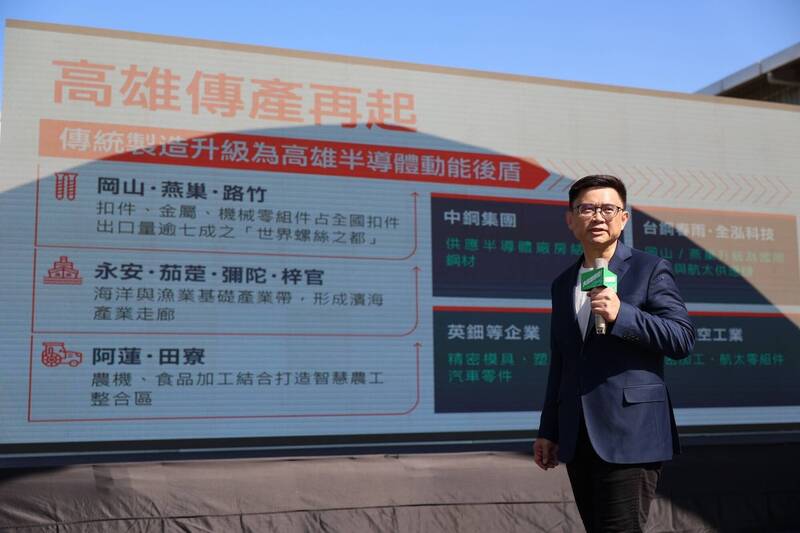By RK Shih / Staff
KAOHSIUNG —Democratic Progressive Party (DPP) lawmaker Lai Jui-lung (賴瑞隆), who is seeking the party’s nomination for Kaohsiung mayor, outlined a sweeping “Grand Vision for North Kaohsiung” on Sunday, vowing to turn the area into “the manufacturing capital for fasteners and chips.”
The Liberty Times reports Lai spoke while in Lujhu District (路竹區), an area he said that was part of 13 districts in north Kaohsiung—Hunei (湖內), Cieding (茄萣), Lujhu (路竹), Alian (阿蓮), Tianliao (田寮), Yanchao (燕巢), Gangshan (岡山), Qiaotou (橋頭), Yong’an (永安), Mituo (彌陀), Ziguan (梓官), Nanzih (楠梓), and Zuoying (左營)—that he believes form a strategic industrial spine for the city.
He argued that by combining fasteners, metals, semiconductors, aerospace and marine technology, together with the coastal “blue economy” and an inland sustainable rural belt, north Kaohsiung can become “the next urban engine and a new global manufacturing core.”
‘World Screw Capital’ plus chips and aerospace
Lai highlighted the Gangshan–Yanchao–Lujhu belt as the heart of Taiwan’s fastener, metal, and machinery components industry, noting that these clusters account for around 70 percent of national export volume, underpinning Kaohsiung’s reputation as a “world screw capital.”
To stay competitive, Lai said he would push a full upgrade of the fastener sector, including:
• Adoption of AI and automation on production lines
• Smart inspection systems to raise quality and traceability
• Integration with the aerospace supply chain to move into higher value-added components
The goal, he said, is to build southern Taiwan’s precision manufacturing center, anchored in north Kaohsiung.
Blue tourism corridor and smart agriculture
On the coast, districts such as Cieding (茄萣), Yong’an (永安), Mituo (彌陀), and Ziguan (梓官) would be repositioned as a “blue tourism corridor”, with:
- Upgraded smart fishing ports
- Low-carbon facilities and green infrastructure
- Policies to transform traditional fisheries into smart fishing plus marine tourism hubs
Further inland, Alian (阿蓮), Tianliao (田寮), and Yanchao (燕巢)—already important agricultural and livestock areas—would be targeted for smart agriculture, using sensor technology and AI data analysis to raise yields and improve efficiency.
Transport upgrades to drive industry
Lai linked the industrial vision to a broader transport plan, saying, “transportation must lead industrial transformation.”
Key projects he cited include:
• The Kaohsiung MRT Gangshan–Lujhu extension onward to Tainan (台南市), forming a Kaohsiung–Tainan tech corridor and a “30-minute living circle”
• The planned second Kaohsiung–Pingtung expressway (高屏第二快速道路)
• Improvements to Provincial Highway 61 (台61線濱海公路) to boost logistics efficiency
Within the city, Lai pledged to roll out:
- AI-based coordinated traffic signals
- AI traffic-flow monitoring systems
- Expanded electric bus fleets and EV charging networks
Together, he said, these would create a new model of green commuting for north Kaohsiung.
Dual-core urban development: Gangshan and Qiaotou
Looking at urban form, Lai described Gangshan (岡山) and Qiaotou New Town (橋頭新市鎮) as “twin cores” for a transformed north Kaohsiung.
- Gangshan would be developed as a northern sub-center, with improved livability, public services, and urban amenities.
- Qiaotou New Town, powered by its science park, would rely on a grid of “three horizontal and three vertical” roads, an extended Provincial Highway 39 (台39線), and a planned second Gangshan interchange, to attract new residents and businesses.
Lai framed the plan as building a smart, livable city that can absorb population growth while supporting advanced industries.



